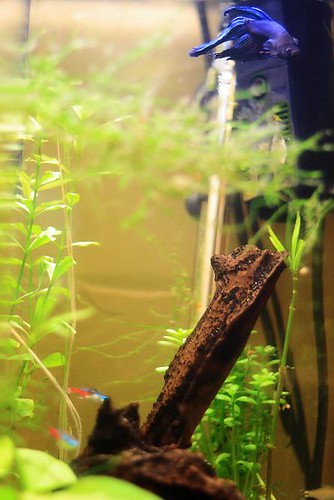Q: M wrote:
WOW I have to say that your website is quite the place to find the answers your looking for so thank you so much in helping people find the right answers to keep their wonderful fish alive and well! I was wonder now if you could help me...I bought a betta fish about a week ago and had him in a bowl at first then decided what kind of home is this I wouldnt want to live my life in some dumb fish bowl so then I decided to buy him a 2.5 gallon fish tank with filter and gravel and I have a fake plant in there for him I leave the light on from about 7:30pm till about 11:00pm plus all the sunlight he gets during the day is that okay to keep the light on that long I just dont like the idea of him being in the dark? Furthermore I was wondering the filter I got for him is 1 of those kinda cheap filters that has a high, medium and low speed I keep it on the low speed but it seems as if its not filtering at all barely any kind of stream coming out the top of the filter and the waters cloudy but then when I put it on medium power it filters great I dont want him to get sucked up into the filter though and I dont want him to be stressed to have to swim so hard Im just confused and depressed because I want him to have a great life for as long as he can. Any information would be so helpful and so appreciated please get back to me asap Loui's scaring me I dont want him to die! OH and incase you couldnt tell this is my first betta LOL :). ANother thing that I thought I'd throw in there since Im asking so many questions already is hes got filmy stuff on the top of his water and hes got build up on the sides of his tank what can I do to get rid of that? Thank you soooo much again your the reason bettas get to live such a long life your such a great source of help and answers and the pet store people are killers they dont care since its not their porblem so thank you!
A: You asked lots of great questions so I will try and answer them in order. In terms of lighting, Bettas, like most animals, use queues from nature to help them know when to be awake and when to sleep. Bettas have a natural sleep cycle that corresponds with the sun. When it's light, they are awake and when the lights go out you can often catch them sleeping in their plants or along the bottom of the tank. I like to give them about 12 hours with the light on and 12 with it off but a little more or a little less doesn't seem to cause any noticeable stress. One thing for sure is that you don't have to worry about turning the light off on your Betta. He'll appreciate the chance to catch some "Z"s.
Determining whether or not your filter is strong enough or too strong is something that a lot of Betta keepers deal with. The sludge you see on the water's surface and aquarium glass is called detritus or "mulm" and may indicate that you need to turn up the filter a little. Detritus is made up of organic compounds in the water and isn't typically harmful but can be an eyesore. Typically, to get rid of it, aquarists create a little more water movement. Since your filter has an adjustable flow control I would recommend turning it up to medium and observing things for a couple of days. If your Betta is really struggling to reach the surface or is cowering completely, then you may have no choice but to turn it down. Another thing you can do is split the difference between low and medium speeds by setting the filter control to medium and adding a few more silk aquarium plants. Extra plants in the water tend to help disperse the water flow making it easier for your fish to deal with the current.
If turning up the filter doesn't remove the detritus you can remove it from the water's surface by folding a paper towel in half and scraping the folded edge across the surface. Detritus that is sitting on the tank bottom can be sucked up with an inexpensive turkey baster, a tool that often comes in handy with Bettas.
Congratulations on your first Betta. I'm thrilled to hear you are doing your homework and providing your fish with great care.



